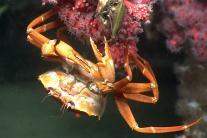Professor leading expedition to study underwater terrain, sea life
Mon, 09/22/2014 - 5:04pmAn associate professor of biology at the University of Louisiana at Lafayette is leading a scientific expedition that’s exploring a series of underwater slopes and canyons off the coast of Cape Cod.
Dr. Scott France and other researchers are studying the New England Seamount chain, which extends about 700 miles to the southeast and consists of more than 30 volcanic peaks. The underwater mountains are dotted with holes and tunnels that provide habitat for a range of species, but are largely unexplored. It is the largest seamount chain in the North Atlantic.
The expedition is being carried out to map underwater topography and to study underwater geological features, marine biology and ecosystems. The National Oceanic and Atmospheric Administration is funding the expedition, which began in August and is scheduled to end Oct. 7.
France, a marine biologist and oceanographer, is aboard the Okeanos Explorer. The 225-foot-long ship is owned by the U.S. government and used for NOAA exploration. It’s outfitted with a sonar mapping system and carries a submersible, remotely operated vehicle, that can explore underwater terrain thousands of feet deep. The ROV, which is tethered to the Explorer via a long fiber-optic cable, transmits operator commands, video and electrical power. It also captures and transmits high-definition video in real time.
“Some of the things you see are jaw-dropping. You feel lucky, because some of the places have never been seen before,” said France in a recent interview. He has participated in similar expeditions in the British Virgin Islands and Hawaii.
France is one of two scientists who guide the underwater vehicle’s movements, based on input from other scientists. He is leading biological exploration, while a marine geologist from Oregon State University is leading geological exploration.
“We will guide the vehicle, explain to viewers what they are seeing, and answer questions that come in from scientists,” he said. France likens his role to that of a ground controller communicating with astronauts. “We’re the conduit between the onshore scientists and what’s happening at sea.”
Video, photos and oceanographic data, such as temperature and depth, will be live-streamed to a team of scientists. Some of the scientists will be stationed at a command center at the University of Rhode Island. Others will access video streams from universities across the United States.
France also will serve as a virtual tour guide for the public, including science students, who can access interactive video feeds and log on to chat rooms at the expedition Web page on the NOAA Web site. “Part of the overall goal of this expedition is to get the public more engaged in understanding the oceans, and to get children excited about science,” he said.
Corals and sponges that grow in abundance in the underwater canyons are of particular interest to France. Stronger currents are funneled through the compressed, V-shaped spaces, scrubbing away soft sediments such as mud, sand, silt and clay. What remains are harder surfaces, such as steep-sided walls, ridges, rocks and boulders to which coral attaches.
France’s research will focus on how fish use the coral ecosystems for habitat, including as spots to lay eggs and to “hide out” from predators. “The places we’re targeting have those really steep cliffs with lots of corral communities, and, as scientists, we’re trying to understand what fish associate with corrals.”
France said some of his students at the University will access live streams for classroom and lab study. “The major interest is biodiversity, essentially why are there so many species in the deep sea,” he said. “There’s no sunlight, temperatures are very cold, and there’s very little food. So my interest is: Why is there so much life down there, and, in terms of corals, how many species are down there?”
Learn more about the Our Deepwater Backyard: Exploring Atlantic Canyons and Seamounts 2014 expedition.

